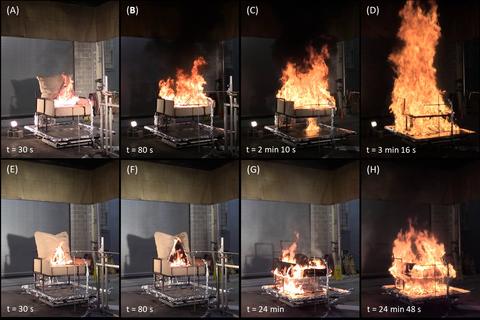Flaming Tests on Upholstered Chair Mock-Ups

The effectiveness and the failure mechanism of fire barriers in residential upholstered furniture (RUF) were investigated by full-scale flaming tests on single upholstered chair mock-ups. Six fire barriers were tested. The fire barriers were screened for (1) the presence of elements that are typically used in fire retardants and, (2) the presence of targeted fire retardants. For each fire barrier, triplicate flammability tests were run on chair mock-ups where polyurethane foam and polyester fiber fill were used as the padding materials, and each chair component was fully wrapped with the fire barrier and a polypropylene cover fabric. The ignition source was an 18 kW square propane burner, impinging on the top surface of the seat cushion for 80 s. Results showed all six fire barriers reduced the peak heat release rate (up to 64 %) and delayed its occurrence (up to 19 min) as compared to the control chair mock-ups. The heat release rate remained at a relatively low plateau level until liquid products (generated by either melting or pyrolysis of the padding material) percolated trough the fire barrier at the bottom of the seat cushion and ignited, while the fire barrier was still intact. The peak heat release rate occurred shortly after. These observations indicated that the failure mechanism of the fire barrier was related to the ignition of the percolating liquid under the chair.
Data
Spreadsheets containing the data from the experiments can be downloaded in the ZIP file provided below. Information about the instrumentation layout, including sensor types and uncertainties, can be found in the reference cited below.
- ZIP file with test data (Microsoft Excel files)
A subset of these data including video footage with data overlay can be found in the NIST Fire Calorimetry Database (FCD).
References
- A. L. Thompson; I. Kim; A. Hamins; M. Bundy and M. Zammarano Performance and Failure Mechanism of Fire Barriers in Full-Scale Chair Mock-ups, Fire and Materials (submitted).
Contacts
-
(301) 975-5244

